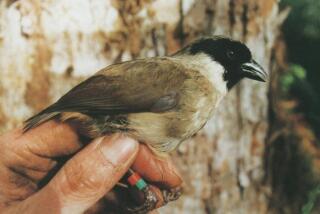Loss of Habitats Could Wipe Out Half of the Species : World in Grip of âExtinction Spasm,â Scientists Warn
NEW YORK â The world is in the grip of an âextinction spasmâ that could mean the disappearance of half the species now living on Earth by the middle of the next century, ecologists say.
More than 1,000 species a year --mostly types of plants and insects--are going out of existence as humans encroach on the rain forests and wetlands that are home to hundreds of thousands of rare forms of life.
âThere have been extinction spasms before, such as when the dinosaurs died off, but never of this magnitude,â said Norman Myers, a British consultant who is considered a leading authority on extinction. âWithin a hundred years, half the species may be extinct. Thatâs a twinkling of an eye in the evolutionary time line.â
Myers and other ecologists met for a recent four-day symposium on conservation issues conducted at Rockefeller University by the New York Zoological Society.
Plants, Birds Dying Out
The conservationists said that many people know hundreds of species of mammals are in danger of extinction, but that most are unaware that hundreds of rare plants, birds and insects are being wiped out every year.
Storrs L. Olson, a researcher at the Smithsonian Institution, said the rate of elimination of species is almost beyond mankindâs capacity to understand.
âOur present lack of understanding of the causes of major extinction events in the paleontological record prevents us from assessing the degree of unnaturalness of the human catastrophe,â he told his colleagues.
The conservationists said species-by-species efforts are not enough to curb the trend. They called instead for worldwide efforts to save large tracts of the rain forests, coral reefs and wetlands that are being destroyed for profit.
They said most of the remaining wild lands affected by the extinction spasm are in developing countries that need help from industrialized nations if they are to save any portion of the fragile habitats.
âThis is a worldwide problem, not a problem of a specific species in a specific country,â he said.
Myers said the extinction spasm dates to 1960, when mass destruction of wild lands began in force. He said that if development continues at its present pace, most of the lands will be destroyed along with half the species on Earth by the middle of 2000.
More to Read
Sign up for Essential California
The most important California stories and recommendations in your inbox every morning.
You may occasionally receive promotional content from the Los Angeles Times.










